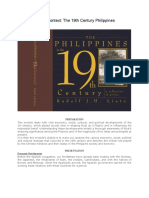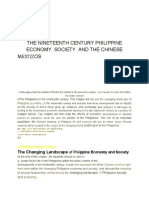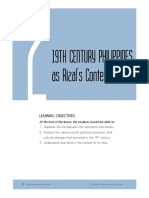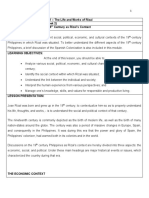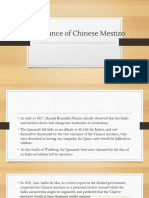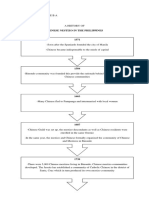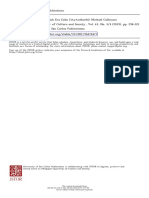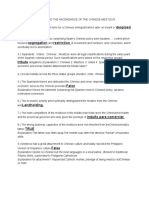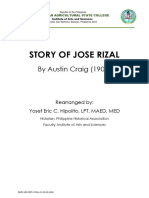LESSON 2 RIZAL 001: THE LIFE AND WORKS OF JOSE RIZAL
The Condition of the Philippines in the Advent of Rizal
2.1. Economic Conditions
Direct trade contact between the Philippines and China dates back to the Sung Dynasty
(960-1279). In the early years of the Spanish conquest, Chinese population in the Philippines
was too insignificant to reckon. In the Manila area, the Spanish conquerors of 1570 found a
small settlement of about 150 Chinese (Anonymous as cited by Wickberg, 2000). But in less
than four decades, the population of Chinese in the archipelago had increased extensively. In
1603, Chinese population in Manila area was estimated at 20,000 against 1,000 Spaniards. The
numerical discrepancy between the two classes resulted to the Chinese trading control of Manila
and the entire Philippines so to speak. Consequently, three economic systems were developed:
Western, native and Chinese economies. The economic classifications were associated to the
three cultural classes: Spaniards, indio and Chinese. Cultural distinction was the basis of the
legal status of an inhabitant. These social classifications occurred only in areas where there is
the presence of both Spaniards and Chinese. It has to be understood that, during that time
Filipino was not among the cultural classifications. This is because the word Filipino was used
to refer to the Spaniards born in the Philippines. Our ancestors were simply called as indio. In
the succeeding discussions, we will be using the term Filipino to mean the natives or the indios.
The unbalanced number of Chinese and their trading success posed a threat to the Spaniards.
Not surprisingly, within a few years after the Spanish conquest, the relation between the Chinese
and the Spaniards fell into a pattern of distrust and latent hostility (Wickberg, 2000). This was
evidently manifested in the uprisings staged by the Chinese against the colonial government. As
regulatory procedure, Spain instigated three important measures: taxation, control and
conversion. Among the social classes, the Chinese were taxed the heaviest. However, their
commercial and industrial triumph was unbothered. The solution taken by the colonial
government was to reduce the Chinese population through expulsion which also proved to be
ineffective. But before long, through royal orders from Spain tried to limit it to 6,000, the
Chinese population, drawn by economic opportunities at Manila, was as large as ever (Wickberg,
2000). Although Catholicism was a strong amalgamating agent among the natives, it did not
work that way for the Chinese. They embraced the religion for the sake of connection rather
than personal conviction. Once baptized, they get Spanish godfathers who occupied positions in
the government to afford them protection for their enterprise. Chinese were restricted to travel or
reside away from Manila. They were confined to the Parian commonly located in the areas near
Manila. However, Catholic converts were allowed to travel to anywhere in the country. This
was an opportunity for them to extend economic activities in other parts of the archipelago. The
conversion of the Chinese into the Catholic faith was a potential mechanism for cultural
integration. This is why intermarriage between the natives and the Chinese was encouraged. As
an incentive, Chinese who married native women were given tracts of land in the areas around
Manila. The intermarriage between the Chinese and the natives resulted to the birth of Chinese
mestizos. And when in the 18th century a sizable number of Chinese-indio half-castes, or
mestizos appeared, a legal classification was created for them too (Wickberg, 2000). The
creation of the mestizo class means an additional classification in the existing social and legal
status of inhabitants. The inhabitants during this time were classified as: Spaniards, indios,
mestizos and Chinese.
-1-
�LESSON 2 RIZAL 001: THE LIFE AND WORKS OF JOSE RIZAL
The Chinese mestizos played an important part in the economic development that took
place in the archipelago in the 19th century. The termination of the Galleon Trade in 1815
created a momentous impact on the Philippines. With the cessation of the galleon trade, the
monopolistic commercial dealing in the country which lasted for 250 years came to an end. The
abolition of the Galleon Trade opened the Philippines to international commerce. As a result,
foreign trade flourished and eventually led to the increase of non-Spanish European residents in
the country. The economic development which transpired during this period paved the way for
the establishment of foreign consulates and the blossoming of healthy and warm foreign
relations. In the dispatches of 1837 and 1841 the French consul, Adolphe Barrot, describes the
liberal treatment given to foreigner residents, and how they were contributing to the economic
development of the country… “By a decree of 1829 foreigners were admitted to Manila on the
same footing as Spanish merchants. Since then, eight or ten British and three American firms
have taken advantage of the generous terms offered by the decree and established themselves in
Manila, where they have achieved varying degrees of prosperity (De la Costa, 1992).” The
effect of the makeovers in the economic landscape of the country benefited not only foreign
merchants but a great number of native workers and the government in general. This attracted
international attention and elicited positive impressions from European traders. In the dispatch
of 1845, the British consul, J. W. Farren, calls attention to the change in the Philippine economy
which had been effected by foreign firms and entrepreneurs… “The character and interests of the
trade in these possessions is now entirely changed. Formerly it was a traffic in the commodities
of other countries exclusively; now it is that in those of its own soil. Formerly it enriched and
employed only the speculators and agents in transaction; now its advantages are diffused through
the laboring masses of the population. Formerly the government of these Islands was sustained
by supplies from Spain; now they contribute nearly half a million annually to the treasury at
home (De la Costa, 1992).” With the official opening of Manila’s port in 1834, trade with all
countries was underway. Subsequently in 1855, trading areas located in different regions of the
country were opened. These were the provincial ports of Zamboanga in Mindanao, Iloilo in
Visayas, and Sual, Pangasinan in Luzon. The port of Cebu followed in 1860 while Legaspi and
Tacloban were opened in 1873.
Through the financial support extended by foreign business firms, agriculture boomed
extensively. Lending houses were opened giving farmers the opportunity to obtain adequate
funds for production. This resulted to a significant increase in the export of agricultural products
which primarily included rice, sugar, abaca, tobacco, cocoa, coffee, hemp fibers and cotton.
Vast agricultural estates were developed and most of them were located in the provinces. The
idea of financing was not new in the Philippines. However, the old scheme did not elicit much
enthusiasm because creditors were not ready to embrace the conditions imposed by the
government. In the early period of the Spanish sovereignty over the Islands, the authorities at
Madrid had decreed that no Filipino could be held liable for the repayment of any loan above
twenty-five dollars, which restriction was evaded later on by securing the loans by a mortgage.
The original intention of the law was to protect the natives from falling into the hands of
rapacious money-lenders (De la Costa, 1992). Financing enterprise flourished earlier and was
practically controlled by foreign business firms. It was only in 1852 that the government
established its own official banking institution, the Banco Espanol-Filipino.
The commercial boom that occurred in the 19 th century profited the Chinese merchants as
much as the European businessmen. The Chinese were typically the middlemen in the
-2-
�LESSON 2 RIZAL 001: THE LIFE AND WORKS OF JOSE RIZAL
provinces. They engaged in the retail of imported goods. Once they had established their
residence in the country, they opened small stores in the towns and formed networks with big
stores in the cities. As reported by Robert MacMicking, “The number of Chinamen in Manila
and throughout the islands is very great, and nearly the whole provincial trade in manufactured
goods in their hands. Numerous traders of that nation have shops opened throughout the islands,
their business being carried on by one of their own countrymen, generally the principal person of
the concern, who remains resident at Manila, while various agents in the country keep him
advised of their wants, to meet which he makes large purchases from the merchants, and
forwards the same to his country friends (De la Costa, 1992).” The foreign traders took
advantage in tapping these existing Chinese linkages to facilitate the distribution of their
merchandise. The special preference given by foreign business firms brought significant gains to
the Chinese merchants. Generally, Chinese acquired goods in bulk directly from suppliers. This
routine cost them lesser and resulted to larger profits. In speaking about this practice,
MacMicking said, “There is another advantage which the Chinese have found from the system
they pursue- that large purchasers of goods from the merchants who import them for sale are
frequently able to buy them for less money than those smaller traders who are not in the habit of
making purchases to the same amount from the importers (De la Costa, 1992).”
The ensuing economic growth in the country prompted the expansion of agricultural
production. This provided opportunity for the enterprising natives and Chinese mestizos who
owned large landholdings in the provinces to increase their cultivation. As commercial
agriculture magnified, the demand for more lands for cultivation became indispensable.
Uncultivated land in the friar estates and other haciendas, previously used only for pasture,
begun to be leased at a fixed rental (canon) by native agricultural entrepreneurs (inquilinos) who
cleared and tilled them with the aid of tenants (kasama) on a share-cropping basis (De la Costa,
1992). The Chinese were indeed determined and skilled entrepreneurs. By the middle of the
19th century, Chinese traders had overtaken their Spanish counterparts. To compete with the
persisting triumph of their competitors, Spanish trading areas were extended to the provinces.
Unfortunately, the said strategy proved ineffective. This circumstance stemmed agitation from
the Spanish entrepreneurs to enforce a drastic move to get rid of the Chinese firms. While the
Chinese, with the capital and prestige of the foreign firms behind them, moved steadily toward
effective control of the retail trade and even of the collection of native produce for export, the
Spanish business community could apparently do nothing more effective than raise an occasional
clamor for the time-honored solution; total expulsion of the Chinese from the country (De la
Costa, 1992). The Spanish businessmen could only wish for themselves a better luck for the
possibility of keeping with their Chinese counterparts was so remote. The remarkable triumph
earned by the Chinese during the last century of the Spanish regime has endured to the
succeeding generations. It provided the momentum which propelled a drastic change in the
political and social landscape of the Philippines. No less than our national hero was one of the
promising upshots of this vital development. It has to be noted that Rizal belonged to a family of
Chinese mestizos.
-3-
�LESSON 2 RIZAL 001: THE LIFE AND WORKS OF JOSE RIZAL
2.2. Political Conditions
The defeat of Napoleon in the French-Spanish War paved the way to the birth of political
adherents called liberals. They were responsible in the writing and passing of the Cadiz
Constitution in 1812 which produced a sounding political transformation in the Philippines.
Patterned after the French Revolution, the new constitution embraced the principle of liberalism
and acknowledged the rights of all citizens, both Spaniards and Spanish subjects. When the
words of the Cadiz Constitution reached the Philippines, the Ilocanos reacted optimistically and
claimed equality with the Spaniards. Far away in the Philippines, when the Ilokanos heard of this
constitution, they said reasonably enough, that since they were now Spaniards, they ought to be
exempted from tribute and statute labor, just like the Spaniards they knew (De la Costa, 1992).
Unfortunately, the share that the poor natives were claiming for was not that fair. The governor-
general was quick enough to respond to the public outcry and immediately appeased the
protesting Ilocanos. However, in Mexico the Spanish creoles (Spaniards born outside of Spain)
having higher political awareness were more persistent and they demanded not only equal rights
but total independence. This assertion resulted to a revolution which resonated to the Philippines.
However, the campaign in the country was less intense and was immediately quelled. One of the
renowned attempts to challenge the Spanish government was led by Captain Andres Novales. He
was a Mexican and an officer of the Spanish military. Novales declared himself emperor of the
Philippines. However, the force that he had was only enough to sustain his delusion for a while.
Novales was not emperor for long. He had a regiment behind him, but not a nation. Loyal
Filipino troops, called out by their Spanish officers, surrounded his pitiful force (De la Costa,
1992).
When Ferdinand VII died in 1833, Isabel II, the child daughter of the king was crowned
queen. Conflict ensued because Don Carlos, the brother of Ferdinand VII claimed the throne.
Don Carlos got the support of the clergy and the conservatives. It has to be noted that the liberals
and the conservatives were at opposing ends. To protect the helpless child queen, Maria Cristina,
the proxy monarch forged alliance with the liberals and concurred with a constitutional
government. The political disorder continued and became more complicated. Subsequently, the
liberals were divided into two factions, the Moderate and the Progressive. The clash between the
two liberal factions resulted to the banishment of the queen regent Maria Cristina who was
replaced by the progressive liberal, General Espartero. Through a union led by General Narvaez,
the moderates, progressives, and republicans joined together and restored the throne. At the age
of 13, Isabel II assumed a symbolic reign of the Spanish empire. The empire was actually ruled
through the dictatorship of Narvaez.
The political turmoil in Spain had greatly affected the state of affairs in its colonies. To
avoid the impending collapse of the Spanish control of its empire the call for unity and prudent
action from the government was deemed necessary. During the 19th century, the head of
government (governor-general) in the country had reduced powers and had to continuously
consult authorities in Madrid for decisions on vital problems and issues. The control and power
to administer the colony was concentrated in Spain. This condition instigated discord and
hindered the implementation of needed reforms. Writing from the Philippines, Juan Manuel de la
Mata expressed this concern to the Minister of Finance, “The mutual interference of unrelated
powers gives rise to frequent disputes and disagreements among the chief officials of the Islands,
and these disputes and disagreements, fanned by imprudent or malicious persons, induce in all
-4-
�LESSON 2 RIZAL 001: THE LIFE AND WORKS OF JOSE RIZAL
branches of the administration a kind of anarchy that engulfs us and that cannot coexist today
with the safety and preservation of the colony (De la Costa, 1992).” The Spanish rule in the
Philippines was at the brink of breakdown. The only way for Spain to save its position in the
colony was to give the Filipinos their fair share. As stressed by de la Mata, “We may still
manage to retain this precious portion of the Spanish monarchy, provided…we lose no time in
taking preventive security measures and exercise the keenest foresight in planning judiciously
and promptly putting in motion the administrative reforms demanded by a new and different age.
Equal justice, prudent firmness and governmental ability have now become indispensable in the
preservation of these important possessions (De la Costa, 1992).”
The inefficient administration that depraved the country was aggravated by the economic
failure in Spain. The political patronage in the Queen’s government resulted to a widespread
corruption and constant economic setback. To sustain their financial requisite, the Spanish
government turned to the Philippines and siphoned its treasury in millions of dollars. So, to
speak, the Philippines became the milking cow of Spain. Most of those who occupied
government positions were appointed not because of their good credentials but rather due to
political and personal connections. In his letter to the Minister of Foreign Affairs, Fabre, the
French consul, described the extent of infiltration political patronage had made in the
government. Fabre conveyed his observation by saying, “The new governor of the Philippines,
General Alcala, is a relative of Esparto and his loyal partisan. The new lieutenant governor,
General Crespo, is a relative of General Alcala. The new director of Tobacco Revenue is a
relative of General Alcala. One of the new oidores is a relative of General Alcala. The
successor-designate of Senor de la Matta as Intendant of Finances of the Islands, Senor Valero, is
a brother of an aide-de-camp of Esparto. Every key position has been given to Espartero’s men
(De la Costa, 1992).” This system resulted to incompetent governance which heavily shaken the
economy of Spain and its colonies particularly the Philippines.
The effect of the new political culture was indeed pervasive. Apart from the economic
drawback, it also caused religious disturbance. Partisan politics paved the way for the liberals in
Spain to set foot on the Philippines. Liberal officials who were sent to the country often
exhibited aversion to the bishops and the clergy who were known sympathizers of the
conservatives. The shrewd attitude of the liberal government officials towards the church
officials tainted the integrity of the bishops and the friars. The unchallenged authority of the
church was now put to a loose end. The natives realized that the religious authorities (bishops
and friars) they used to revere and regard as untouchables were actually no extraordinary beings.
Eventually, the natives gained courage and they too began to question the misconducts and
delinquencies committed by some friars. Prominent among those who distinctly demonstrated
their opposition to the abuses and immoral practices of the Catholic Church was Jose Rizal.
The problem faced by the Catholic Church was not altogether external. During the latter
part of the 19th century, some liberal minds within the organization began to sprout. It has to be
understood that the clergy was composed of the Spanish friars and native priests. The
anticlerical attitude of the liberals was generally directed against the Spanish clergy. In fact,
native priests themselves were also against the friars. As a matter of principle, the administration
of the parishes was only given to the Spanish clergy. Generally, native priests were assigned as
assistants. However, the clamor of some native priests for equality gradually emerged. The cry
for fair opportunity in the administration of the parishes gave birth to the secularization
-5-
�LESSON 2 RIZAL 001: THE LIFE AND WORKS OF JOSE RIZAL
movement. The expulsion from the Philippines of the Jesuit friars in 1768 opened the
opportunity for the native clergy to take charge of the parishes. This occasion was indeed
something to cherish for the secular priests. However, it was just short-lived. The conflict that
ensued between the liberals and the clergy in Spain resulted to the exile of large number of
Spanish friars to the Philippines. The influx of Spanish clergy to the country was incessant and
the native priests regarded it with great apprehension. Of course, the Filipino clergy had
sufficient reason to be anxious about it. As Fabre stated in his correspondence to the Minister of
Foreign Affairs, “The native clergy, who a few years ago had charge of practically all the
parishes, are now witnessing the daily arrival of numerous Spanish religious who had been
expelled from Spain by the reaction which has taken place against them in that country, and to
whom the best parishes here are being assigned. Thus, the prospects of advancement of the
native clergy are being increasingly reduced, and they are not viewing this development without
disturbance and evident dissatisfaction (De la Costa, 1992).” The arrival of the Spanish priests
from Europe prompted the archbishop to evict the native priests from their parish assignment in
favor of the newly arrived Spanish clergy.
Opposition on the move to take back the parishes from the native priests began to surface.
Among the Filipino priests who questioned the plan for reorganizing the parishes, Fr. Jose
Burgos was the most outspoken. Burgos argued that linguistic barrier could be unfavorable to
the welfare of the local churches and the idea of giving the charge to the Spanish clergy was
premature. In his response to the secretary of the archbishop, Burgos clearly manifested this
point by saying, “With regard to my having intervened in such a way as to make the fathers from
Pamplona feel that they were being deterred from occupying the posts assigned to them by Your
Lordship…I merely made the observation that since…(they) are not familiar with the languages
of the parishes that they are supposed to officiate…it was in my opinion not merely advisable but
proper that they should begin as coadjutors (assistant) in said parishes, and until they shall have
acquired some knowledge of these languages (De la Costa, 1992).” If in Spain the clergy were
losing their grounds, in the Philippines the Church hierarchy still managed to hold on to their
power and influence. In fact, the governor-general could not help but extend favor to them
despite their political disagreements. This circumstance provided the church an expedient
opportunity to eliminate anyone who went against their way. To make the story short, they were
able to deceptively implicate Burgos and his accomplices Gomez and Zamora in the 1872 Cavite
Mutiny. The fabricated accusation led to the death of the three Filipino martyr priests. However,
this unfortunate event left a stinging mark on Spain for the unjust execution of Gomez, Burgos
and Zamora would have a significant influence in the making of a national hero, Jose Rizal.
From his older brother Paciano who was a disciple of Fr. Jose Burgos, Rizal saw the injustice
and ruthlessness of the Spaniards. In memory of their martyrdom, Rizal dedicated his second
novel, El Filibusterismo to the three martyr priests.
-6-
�LESSON 2 RIZAL 001: THE LIFE AND WORKS OF JOSE RIZAL
2.3. Social Conditions
The economic development which started in the early part of the 19 th century brought
about massive change in the social atmosphere in the Philippines. Although it benefited
practically all the natives, some groups got the bigger share. Among those who were bestowed
with greater recognition were the members of the principalia or the elite families of native
Filipinos which later formed the new social group, the middle class. The members of the
principalia were the former datu and his family. Because of their respectable social status, the
principales usually were elected as gobernadorcillo (little governor) whose main function was
the collection of taxes in their respective pueblos (town). As a result of the economic boom, the
towns gradually became more established and independent. This called for the expansion in the
duties and responsibilities of the gobernadorcillo. From simple tax collectors, they had to take
charge of carrying out various administrative tasks. Trade and government demanded not only
that he collect the tribute (tax) but that he build roads and keep them open, build bridges and
keep them repair, operate ferries, police town and countryside, maintain regular communication
with the capital, lodge and feed travellers, enforce the state monopolies, and do a sizable amount
of paper work (De la Costa, 1992). From this standpoint, we can say that the gobernadorcillo
was now performing the work of a real town mayor.
However, despite the enormous undertakings of the gobernadorcillo, he did not receive
fair remuneration. In fact, he was left alone by the government to look for finances so he could
accomplish the tasks given to him. Nevertheless, the position provided them something more
than monetary reward. A good indication of the level of prosperity and cultivation the members
of the new native middle class had achieved is the measure of social acceptance now being
extended to them by the Spaniards and other Europeans (De la Costa, 1992). By this time, the
gobernadorcillo was enjoying the liberty in administering his town. Consequently, he initiated
reforms and led the people in the way that fit them and the results were promising. The ensuing
developments elevated both the social and economic status of the middle class who gradually
formed into a new breed of Filipino elite. The amenities of life and the considerable freedom that
they enjoyed broadened the capability and spirit of the native middle class. With their economic
and social leverage, the principalia together with the families of Chinese mestizos were able to
send their children to study in institution of higher education in the Philippines and Europe. This
breed of educated Filipinos was called as illustrados (enlightened ones). The trainings acquired
and the liberty experienced by the illustrados in Europe led to the cry for reforms in the
Philippines. They had grown defensive and would not easily give in to the whim of the Spanish
authorities. At this point, the government was facing an adversary that would later bring them to
their downfall.
Looking at the other side of the coin, we can see a different story. If the native elite were
gaining grounds, the Filipino working class remained almost unbothered. Their traditional
attitude and perception toward the Europeans, particularly the Spaniards persisted. They
continued to be enslaved by their ignorance and were easily persuaded by the government. The
antagonism of the middle class on the abuses and immorality of the Spanish authorities could
hardly be sensed from the working class. Attempts to utter resentment, if there was any, were
easily dissuaded by their fascination at their Spanish masters. In the face of their inconvenient
life, they continued to be still and faithful to the church and the government. The lower-class
Filipino, despite occasional outbursts of unaccountable fury, seemed still to be, in general, what
-7-
�LESSON 2 RIZAL 001: THE LIFE AND WORKS OF JOSE RIZAL
he had always been: “teachable, obedient, industrious, loyal to King and country,” and accepting
the domination of the white man as part of the immutable order of things (De la Costa, 1992). It
seemed that the Filipino working class had perfectly accepted their fate as servants to Spain and
for them this kind of arrangement was unquestionable. However, this outlook did not yield for
long for the cry of the Filipino elite would soon reach their doorsteps and eventually the working
class would find their selves in the frontline of the revolution.
The rise of the principalia and the shaping of the native elite had played substantial part
in the making of what we are now. As what one historian said, “We are what we are, because
they were what they were.” Without the middle class, perhaps there would have been no Rizal,
the man who moved the soul of every Filipino in all social status to wage the ultimate war
against the colonizers. The emergence of the middle class was indeed dramatic. It was inspiring
because from its rank, a seed had sprouted and yielded the sweetest fruit that we could ever taste,
that is, our independence. The revolution initiated by the elite class was truly remarkable and
with Rizal, their greatest champion and inspiration, victory awaited the Filipino people. Jose
Rizal was not just elite. He was the first Filipino.
-8-




















